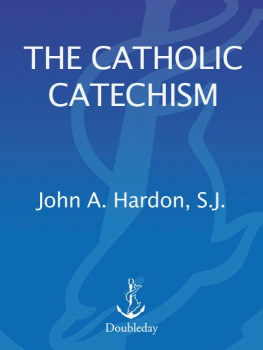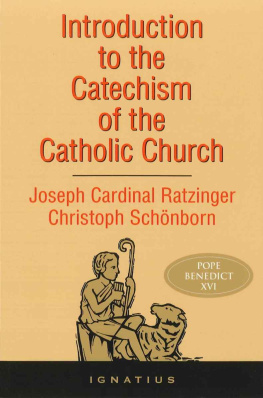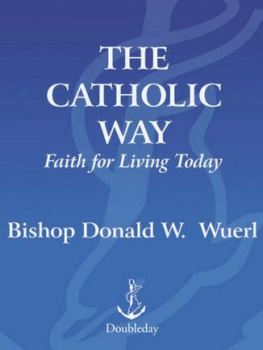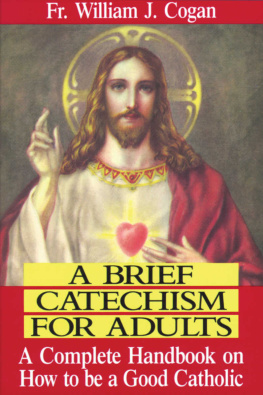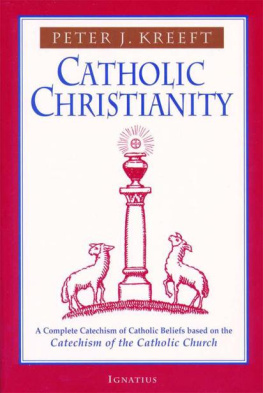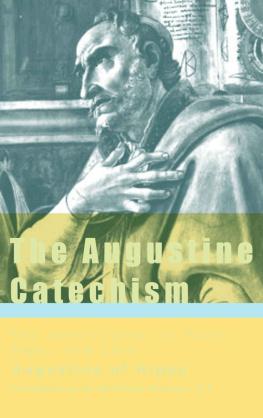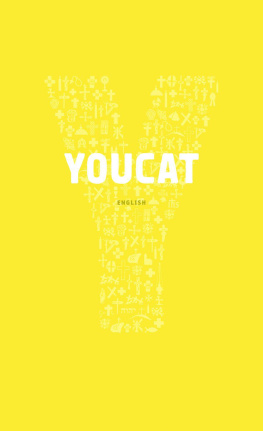Table of Contents
lmprimi potest: Very Reverend Joseph Daonst. SJ. Provincial, Detroit Province,
August 8, 1994.
Imprimatur: Bishop Alvaro Corrado, S.J., October 4, 1994
The Nihil obstat and the imprimatur are declarations that this work is considered to be free from doctrinal or moral error. It is not implied that those who have granted the same agree with the contents, opinion, or statements expressed.
References to The Catechism of the Catholic Church have been translated by the author from the French edition of this work ( Catechisme de I Eglise Catholique ) with gratitude to the publishers Mame-Librairie Editrice Vaticane, 1992, Paris.
All Scripture references have been translated from the Latin vulgate by the author, unless otherwise noted.
Cover design by LUCAS Art & Design, Jenison, Michigan
Book design by Mark Sullivan
Library of Congress Cataloging-in-Publication Data
(from original edition)
Hardon, John A.
The faith : a popular guide based on the Catechism of the Catholic Church / John A. Hardon. S.J.
p. cm.
Includes index.
ISBN 0-89283-875-2
1. Catholic Church. Catechismus Ecclesiae Catholicae. 2. Catholic ChurchCatechisms. 3. Catholic ChurchDoctrines. I. Catholic
Church. Catechismus Ecclesiae Catholicae. II. Title.
BX1959.5.H37 1995
239.2dc20 94-41457
Copyright 1995, by John A. Hardon, S.J. All rights reserved.
ISBN 978-1-61636-775-6
Published by Servant Books, an imprint of Franciscan Media
28 W. Liberty Street
Cincinnati, Ohio 45202
www.FranciscanMedia.org
Acknowledgments
The author owes special thanks to many people whose generous assistance has made possible the publication of this book.
To my Jesuit Provincial, V. Rev. Joseph Daoust, S.J., for the Imprimi potest.
To Bishop Alvaro Corrado, S.J., for his Imprimatur.
To His Eminence Jose Cardinal Sanchez, for his strong moral support.
To Mr. and Mrs. John (Dolores) OConnell, for their indispensable help as coordinators in the publication of this manual for The Catechism of the Catholic Church.
General Introduction
Understanding The Catechism of the Catholic Church
The twentieth century is the most critical in the history of Christianity. The decades since 1900 are more than so many years that might just as well apply to any other period of history. They mark the beginning of a new age in human civilization and, correspondingly, of the Christian religion.
What does this have to do with our subject, Understanding The Catechism of the Catholic Church ? Everything. Unless we realize the providential period through which the Church is now passing, we shall look upon The Catechism of the Catholic Church as just another book, or just another piece of religious literature.
This catechism is of historic importance. Depending on how seriously we take it, the future of the Catholic Church will be shaped accordingly. We may legitimately look forward to the twenty-first century as the most glorious since the coming of Christ. But we must capitalize on the gift He is giving us in The Catechism of the Catholic Church.
Understanding the Faith Taught by The Catechism
The Catechism of the Catholic Church (hereafter The Catechism ) is not a mere collection of doctrines. It provides the groundwork for understanding what we Catholics believe. On this level, The Catechism is unique.
The Holy Spirit guiding the Church knows that the modern world is the most academically sophisticated in history. In America alone, over five million students go to college every year. We are trained to the hilt in every humanistic subject under the sun. But most Catholics are undereducated in their faith. The result is predictable. By the time they finish even their secondary education, they find themselves in conflict in their own minds. They are trained in science, history, and world literature. At the same time, their minds have been, to say the least, undertrained in the religion they profess. What happens? They abandon their Catholic faith as a remnant of childhood.
The Catechism provides the beginning of what should be considered the single greatest Catholic need in the world today, namely, to understand what we believe.
Recall the sower parable of Our Lord as narrated by St. Matthew. The sower in the parable sows all good seed, but on four different kinds of ground. Only the last soil produces any yield. It is especially the first fruitless soil that applies to these reflections here.
In the words of Christ, as the sower sowed the seed, some seeds fell on the edge of the path; and the birds came and ate them up.
When the disciples asked Jesus to explain the parable, He told them, When anyone hears the words of the kingdom without understanding, the Evil One comes and carries off what was sown in his heart. This is the man who received the seed on the edge of the path (Matthew 13:10, 1819).
Thats it! It is both that simple and that serious. The seed of Gods revealed truth has been sown in our hearts at Baptism. But that was only the beginning. We must do everything in our power to grasp the meaning of what we believe. Otherwise, the devil will come along and steal the faith from our hearts.
There has never been a substitute for understanding our Christian religion. There is no substitute today. But now this understanding is absolutely imperative. The world in which we live is too determined to take from our hearts what we believe.
That is why The Catechism is such a providential godsend. It not only provides the believing Catholic with information about what to believe; it also gives us an explanation of the meaning of what we believe.
Of course, The Catechism is only a start. But it promises to be a powerful initiative for waking up a sleeping Catholic world to the duty we have to know:
- what we are to believe on the revealed word of God;
- what the faith we profess is all about;
- that Christianity is the most credible religion in the world and, within Christianity, that the Catholic Church has the fullness of the truth;
- that, as a result, we Catholics have a grave responsibility for educating a world that is starving for knowledge of Christ and His truth.
Understanding Why The Catechism Is So Important
It is one thing to know theoretically what Catholics are to believe. It is something else to know where to find the true faith expressed in straightforward and unambiguous language.
The confusion among Catholics on even the most fundamental doctrines of faith and morals is widespread.
There is no ambiguity in The Catechism. People may not want to accept what The Catechism teaches. That is their problem.
Someone somewhere in the Church founded by Christ must be in a position to tell the faithful, This is true, and that is false, or, This is morally good, and that is morally bad. Otherwise, the very existence of Christianity is in danger and the survival of the Catholic Church in any given country or locality is in jeopardy.
That is why The Catechism has not been released one month too soon. It is the hope of restoring unity in a widely dismembered Christianity.
Understanding How to Use The Catechism
We still have one important aspect to explain. It is also the most important practical question that needs raising. How is The Catechism to be put into apostolic use?
Before going any further, certain things should be made clear.
The Catechism is no mere reference work that we may occasionally consult, like a standard dictionary or encyclopedia.
The Catechism is no mere summary of religious ideas or ideals that provides a readable handbook on how Catholics think.


